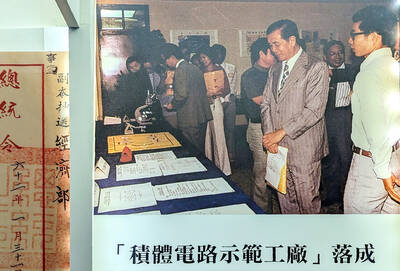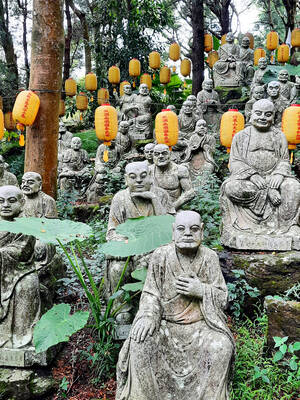Creative Taiwanese cuisine meets rustic tranquility at Shi-Yang Culture Restaurant (食養山房), located at a mountainside property on Yangmingshan. The restaurant, which first opened as a modest teahouse in Sindian in 1996, offers one of Taipei’s more unique dining experiences.
Shi-Yang is about slowing down, soaking in the sights and savoring every morsel. It takes three hours to serve this artfully presented 10-course meal, which is priced at NT$1,100 per person (NT$935 for vegetarians). There is no a la carte selection — the prix fixe menu is determined by whatever fresh and local ingredients are available.
The lush forest grounds of Shi-Yang, which cover around 5 hectares, look more like a quiet spiritual retreat. Indeed, owner and chef Lin Pin-hui (林炳輝) lives there with around 20 staff members; they start every morning together by reading Buddhist prayers.
Before entering one of the restaurant’s three dining rooms, patrons take off their shoes to walk on the tatami-covered floor. The minimalist decor has a decidedly Zen flavor, with table displays of sutras written on scrolls and a few antique Chinese sculptures.
Shi-Yang’s meals are a healthier take on the traditional Taiwanese banquet. Seafood shows up in many dishes, but fresh vegetables receive a lot of emphasis.
Each course was a surprise or delight, often both. Our meal started with a trio of sparsely presented but memorable appetizers. The centerpiece was a slice of homemade peanut tofu, which had a grainy texture but a pudding-like consistency.
The bite-size portion of chilled eggplant, string beans and a sliver of ginger was a symphony of flavors and textures: silky and rich, sweet and crunchy, light and zesty.
One of my dining companions had already been won over by another bite-sized hors d’oeuvre: smoked salmon wrapped in roasted green pepper and topped with onion and salmon roe. Her reaction: “This was worth the trip.”
The appetizers were followed by a light, frothy concoction of blended strawberries and passion fruit, served in ceramic espresso cups with a flower on the side. Also worth the trip.
Each course arrives at a relaxed pace — enough time to marvel over the food, sip high mountain tea (高山茶) and admire the surroundings. Wall-sized windows offer views of the adjacent gardens during the day; candles light the space in the evenings. The recorded sounds of a Chinese zither set a contemplative mood, while the lively chatter of diners brings a cozy warmth to the room.
We cleansed our palettes with homemade drinking vinegars, one brewed with rose petals and the other with pineapple. Both were excellent and served as the perfect segue to the latter half of the meal, where the flavors grew more intense. Shi-Yang added an imaginative twist to mochi (麻糬), filling their savory version of this sticky rice cake with mullet roe and then frying it in a light tempura batter. The mochi was accompanied by a slice of sweet potato, also fried in tempura batter, served on a bed of cabbage.
East and West came together in the salami roll, a slice of Italian dried sausage served on top of mushroom fried rice and shaped like nigiri sushi. This dish was one exception to the restaurant’s local-ingredients-only ethos.
The highlight of the meal, a fragrant chicken soup with lotus root and mushroom, was also the most visually pleasing. The waiter brought the soup over in a clay pot, opened the lid and then placed a dried “perfume lotus flower” (香水蓮花) on top. The petals opened up before our eyes, and seemed to melt into the soup.
A floral theme runs throughout the meal — a large sprig of fern adorned a platter of fresh abalone, squid sushi rolls and sashimi tuna wraps were served on a bed of ice. But one of the most beautiful-looking dishes was the simplest: a steamed egg custard, served in a ceramic cup and tray glazed in pale blue with a freshly cut crimson flower on the side.
Shi-Yang is currently in the process of moving to another mountainside property in Sijhih (汐止), which opens in mid-December. The Yangmingshan location is open until then. The restaurant’s Web site has details on the new location.
Reservations are a must.

Oct. 27 to Nov. 2 Over a breakfast of soymilk and fried dough costing less than NT$400, seven officials and engineers agreed on a NT$400 million plan — unaware that it would mark the beginning of Taiwan’s semiconductor empire. It was a cold February morning in 1974. Gathered at the unassuming shop were Economics minister Sun Yun-hsuan (孫運璿), director-general of Transportation and Communications Kao Yu-shu (高玉樹), Industrial Technology Research Institute (ITRI) president Wang Chao-chen (王兆振), Telecommunications Laboratories director Kang Pao-huang (康寶煌), Executive Yuan secretary-general Fei Hua (費驊), director-general of Telecommunications Fang Hsien-chi (方賢齊) and Radio Corporation of America (RCA) Laboratories director Pan

President William Lai (賴清德) has championed Taiwan as an “AI Island” — an artificial intelligence (AI) hub powering the global tech economy. But without major shifts in talent, funding and strategic direction, this vision risks becoming a static fortress: indispensable, yet immobile and vulnerable. It’s time to reframe Taiwan’s ambition. Time to move from a resource-rich AI island to an AI Armada. Why change metaphors? Because choosing the right metaphor shapes both understanding and strategy. The “AI Island” frames our national ambition as a static fortress that, while valuable, is still vulnerable and reactive. Shifting our metaphor to an “AI Armada”

When Taiwan was battered by storms this summer, the only crumb of comfort I could take was knowing that some advice I’d drafted several weeks earlier had been correct. Regarding the Southern Cross-Island Highway (南橫公路), a spectacular high-elevation route connecting Taiwan’s southwest with the country’s southeast, I’d written: “The precarious existence of this road cannot be overstated; those hoping to drive or ride all the way across should have a backup plan.” As this article was going to press, the middle section of the highway, between Meishankou (梅山口) in Kaohsiung and Siangyang (向陽) in Taitung County, was still closed to outsiders

The older you get, and the more obsessed with your health, the more it feels as if life comes down to numbers: how many more years you can expect; your lean body mass; your percentage of visceral fat; how dense your bones are; how many kilos you can squat; how long you can deadhang; how often you still do it; your levels of LDL and HDL cholesterol; your resting heart rate; your overnight blood oxygen level; how quickly you can run; how many steps you do in a day; how many hours you sleep; how fast you are shrinking; how